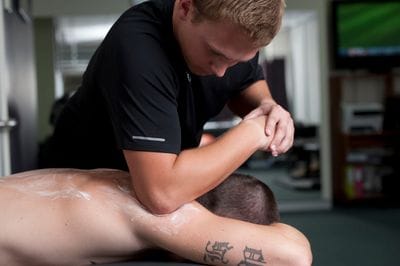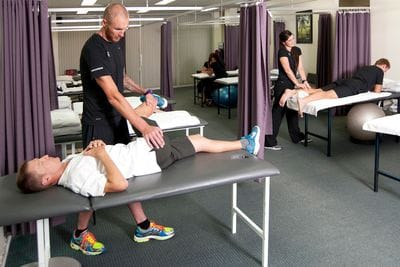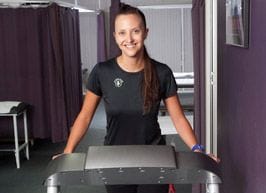Hamstring Muscle StrainWritten on the 11 December 2013 by Active Body Physiotherapy What Is It?A hamstring muscle strain refers to a tear in the muscle group which covers the back of the thigh. How Does It Happen?A hamstring muscle strain typically occurs when the muscle is contracted with excessive force in a stretched position. This commonly occurs during running or sprinting just before or after the foot hits the ground. In this position, the hamstring muscle group is stretched over the back of the hip and knee joints whilst it is working hard to slow down the forward swinging leg and secondly propel your body forward. How Does It Feel?When the hamstring muscle is strained, the first sensation you feel is sudden pain in the back of the thigh, due to damage to muscle fibres. At the same time you may have a 'tearing' sensation. With a minor strain, you may be able to continue participation with minimal restriction. However, as the muscle cools down following activity, pain may gradually increase as bleeding and swelling around the injured muscle continues. This may be associated with progressive tightening and stiffening of the hamstring muscle group. In more severe strains, these sensations may be exaggerated such that you are unable to continue participation due to excessive pain in the thigh, muscle tightness, weakness and spasm. In these cases, the pain may be so intense that you are unable to walk without a limp. There may also be obvious swelling and a visible defect in the muscle. What Should You Do?To limit the severity of this injury, it is advised you stop your activity immediately and start initial treatment. The most important time in the treatment of any injury is the first 24 – 48 hours. Swelling is a necessary step in the healing process; however, too much swelling can delay healing and cause further tissue damage. To control the amount of swelling and limit the degree of damage to the hamstring muscle, the RICE regimeshould be commenced (Rest, Ice, Compression, and Elevation). This will help to reduce blood flow to the injured area, thereby, reducing the extent of swelling and tissue damage. You should continue the RICE regime until you consult a physiotherapist, preferably within 2 days of the initial injury. What Shouldn't You Do?Following a hamstring muscle strain, you shouldn't undertake activities which increase blood flow to the hamstring muscle. These include hot showers, hamstring stretching, heat rubs, massage, consumption of alcohol and excessive activity. These can increase muscle bleeding, resulting in further pain and an extended recovery period. Could There Be Any Long Term Effects?Although most hamstring muscle strains heal without complication within a number of weeks, a proportion of injuries can result in longer term effects, depending on the extent of damage and inappropriate early management. When the hamstring muscle is torn, a number of structures contained within and around the muscle may be injured. Injury to these structures may delay return to sports participation. This may also result in a tight or weakened hamstring muscle group that is prone to reinjury when returning to activity. Reinjury may also result if the cause of the initial hamstring tear was not accurately diagnosed and addressed. Management
The assistance of a Physiotherapist is important in the treatment of a hamstring muscle strain. Initially, they can assist in determining the exact tissue/s damaged and the extent of this damage. From this information, an indication of how long the injury is expected to take to heal can be determined. Physiotherapists can also use a number of other treatment techniques to assist in reducing pain and swelling and enhance the healing of the injured structures. This should also include an appropriate progression of exercises aimed at increasing your range of motion, strength and function. These exercises will facilitate your return to sports participation and, by identifying the reason why you tore your hamstring, help prevent reinjury. This can be performewhilst minimising the risk of a re-bleed and will accelerate your return to sports participation. Author:Active Body Physiotherapy |
Exercise Physiology
Individualised and structured exercise programs, specialised in return from injury, athletes or individuals wanting to improve performance, strength, power, speed, endurance, flexibility and/or overall lifestyle.







